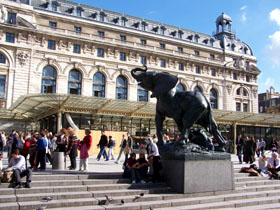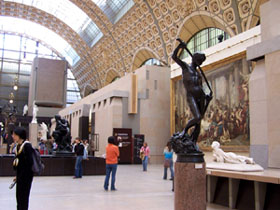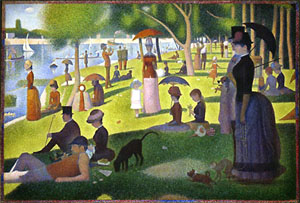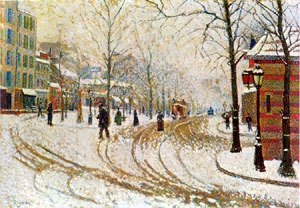Biographies (click |
 |
1 8 7 4 |
Musée d'Orsay |
1 9 8 6 |
 |
Where to see Impressionist paintings in PARIS
![]() Permanent Exhibitions :
Permanent Exhibitions :
![]() ORSAY MUSEUM (MUSEE d'ORSAY) :
ORSAY MUSEUM (MUSEE d'ORSAY) :
THE MUSEE D'ORSAY, A NATIONAL MONUMENT AS WELL AS A MUSEUM
The Musée d'Orsay was opened to the public in 1986 in place of the former "Gare d'Orsay" (Orsay Station) which had become too short for modern electric trains. The building, a very imposing one, was built by architect Victor Laloux and inaugurated at the World Fair of 1900. It was designed to be perfectly integrated with its prestigious vicinity, the Louvre and the Palais de la Légion d'Honneur, and also to include an hotel.
The station building, one moment threatened of destruction, will be finally classified as an Historical Monument in 1978 and the decision was taken to amenage it as a museum under Valéry Giscard d'Estaing's Presidency ( in 1977).
The Orsay Museum was inaugurated by President François Mitterand in 1986. Its collection then regrouped, according to chronological criteria, art works coming mainly from the Louvre Museum, the "Musée du Jeu de Paume" and the "Modern Arts Museum" (this latter being today located in the Centre Georges Pompidou)
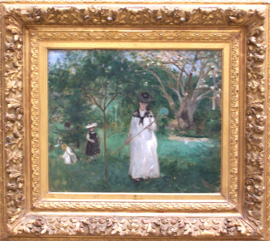 "Butterfly catching" Berthe Morisot, 1874 |
Orsay's collection of Impressionist masterpieces is outstanding, to such an extent that the new curator of the Museum, Mr Serge Lemoine declared to "Express Magazine" (in june 2002) : "The great Gallery of Impressionists should be rethought. There are there many masterpieces, but the addition of such a number of paintings of similar dimensions is prejudicial to visitor's vision". |
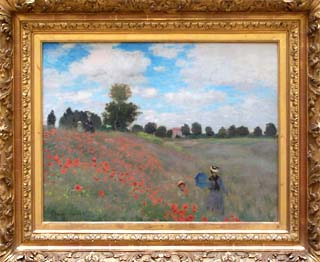 "Red poppies at Argenteuil " Monet, 1873 |
Nevertheless, "mieux vaut faire envie que pitié" : Manet, for instance, is represented with "Lola de Valence", "Luncheon on the grass", "Olympia", "Bullfight","Portrait of Emile Zola", "Le fifer", "The reading", "The balcony", "Portrait of Berthe Morisot", "Lady with fans , portrait of Nina de Callias", "The waitress (The girl serving beer)", "Blond with bare breasts "... and several still life paintings such as "Pinks and Clematis in a Crystal vase"...!
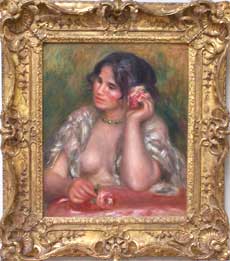 "Gabrielle with a rose" - Renoir, 1911 |
A visit at the Orsay Museum gives the opportunity to better appreciate masterpieces as they really are (dimensions, colors...) whereas we only know them as images. It is also a possibility to discover many Impressionists' paintings that are not known of as masterpieces but which are just as brilliant. |
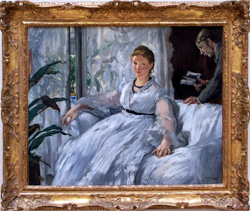 "The reading" Manet, 1873 |
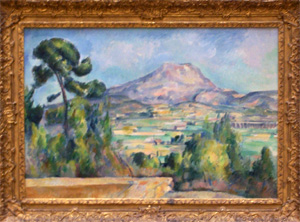 "Sainte-Victoire mountain" Cézanne, c. 1890 |
Photographs made at the Musée d'Orsay |
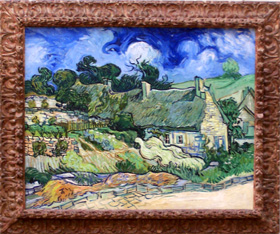 "Cottages with thatched roofs, Auvers-sur-Oise" Van Gogh, 1890 |
![]() MUSEE MARMOTTAN :
MUSEE MARMOTTAN :
The Impressionist collection of the " Musée Marmottan Monet " is a very complete one and is representative of this Movement. It counts over three hundreds paintings , pastels, watercolors and sculptures from artists founders of Impressionism or who joined it afterwards : Caillebotte, Degas, Manet, Berthe Morisot, Pissarro, Renoir, Sisley...
Most of these works were owned by Claude Monet, Berthe Morisot, or by the first Impressionist patrons and collectors of that time such as Ernest Hoschedé, Henri Rouart, Georges de Bellio.
![]() Temporary Exhibitions :
Temporary Exhibitions :
- Running
- To come
- Over
![]() "Turner,
Whistler, Monet" until 15/05/2005
"Turner,
Whistler, Monet" until 15/05/2005
at : TATE GALLERY, LONDON
In 1870, Monet refused to serve in the army of Napoleon III against Prussian army and seeked refuge in London. There he discovered the works of Constable, William Turner (1775-1851), and the first "Nocturnes" of James Abbott Whistler (1834-1903). This latter , an american painter, definitely settled in London after a few years spent in Paris where he was an admirer of Manet.
The exhibition presents works of Monet inspired by Thames river and its fog effects, as well as later paintings on the same subject, in parrallel with paintings of Turner and Whistler
...
Exhibition ![]() "Turner,
Whistler, Monet"
"Turner,
Whistler, Monet"
![]() Neo-Impressionism,
from SEURAT to Paul KLEE from 15/03/2005 until 10/07/2005
Neo-Impressionism,
from SEURAT to Paul KLEE from 15/03/2005 until 10/07/2005
at : MUSEE d'ORSAY
While Impressionist painters, whose last group exhibition was held in May 1886, were at last about to be acknowledged, new artistic trends were beginning to take shape in French avant-garde painting.
Several of them were in relation with the Symbolism movement, an idealistic movement born in the literary world, proclaiming that symbols and ideas are essential in art and should replace a strict realistic approach. These artistic currents will break apart from Impressionism and are today all together amalgamated as Post-Impressionist (Synthetism of Gauguin, Pont-Aven School, Nabis, German Expressionnism...).
On the other hand, Neo-impressionism, strictly speaking, refers at its beginnings to an innovating pictural technique, and will keep the realistic themes of Impressionism : contemporary life, urban landscapes, leisure activities, seaside scenes...
In the early 1880s French painter Georges SEURAT gets particular interest in recent scientific studies about colors (Eugène Chevreul, Rood, David Sutter) and invents a new pictural technique where juxtaposition of tiny touches or dots of pure color is used instead of mixing colors on the painter's palette. When seen from an appropriate distance, dots blend with one another to produce more lively color effects than if color pigments were physically mixed together.
Seurat will name this new method "Divisionism", standing for "division of tones".
The large painting (206x305 cm) "A sunday afternoon on the Island of La Grande Jatte" - 1884-1886 by Georges Seurat, may be considered as the founding work of the Neo-Impressionist movement, since it will draw considerable attention, at the Impressionist Exhibition and at the "Salon des Independants" in 1886, at the Belgium "Salon des Vingt" in 1887 . From that date on, many painters will adopt Seurat's technique, in France, soon in Belgium, Netherlands, Germany and Italy. Pissarro, who met Seurat in 1885, adopted his divisionist technique, which he would referred to as a "Scientific Impressionism". |
Van Gogh too, as he arrived in Paris in 1886, carefully studied Seurat's theories and painted several works in the divisionist manner, at the same time he lightened his palette.
After Seurat's death in 1891, Pissarro gave up with divisionism, and later wrote he was forced to the conclusion that "he could not follow his feelings, give life and movement... Probably I was not born for this art which gives me the feeling of death levelling".
From the beginnings, French painter Paul Signac was the most fervent adherent and propagandist of Divisionism, which he preferred name "Pointillism", before he agreed with French journalist and critics Félix Fénéon's name of "Neo-Impressionism". After Seurat's death at the age of only 32, Signac will be the leader of the Neo-Impressionist movement, the main representatives of which are Charles Angrand, Louis Anquetin, Henri-Edmond Cross, Maximilien Luce, Lucien Pissarro. From 1895 on, Paul Signac's work will evolve towards a new Neo-Iimpressionism, with larger and more colored touches.
|
As an autonomous movement, Neo-Impressionism represented only a brief transitional period, and a limited number of artists did stick to it throughout their lifetime, such as Signac and Cross.
However, its place in art history remains essential, due to the high quality of the works of its main representatives - Seurat, Signac, Cross -, and moreover to its research on use of pure colours in painting, that will soon lead to Fauvism.
![]() " The
ROUART Family : in the heart of IMPRESSIONISM" until 13/06/2004
" The
ROUART Family : in the heart of IMPRESSIONISM" until 13/06/2004
at : MUSEE DE LA VIE ROMANTIQUE
(Hôtel Scheffer-Renan, 16 rue Chaptal, 75009 Paris)
The Rouart, a well-known family of painters and art collectors, lived in Paris the pictorial revolution of the end of 19th century and was also involved in the litterary and musical effervescence at the turn of the century. The exhibition gives an idea of the prestigious collection owned by this family of enlightened art amateurs (Corot, Degas, Delacroix, Manet...), as well as more intimate works of other painters, some of them being members of the Rouart dinasty : Ernest Rouart, Julie Manet, Augustin Rouart... About a hundred of paintings, watercolors and sculptures are shown , altogether with unpublished writings and photographs.
![]() "Johan
Barthold JONGKIND" from 01/06 until 05/09/2004
"Johan
Barthold JONGKIND" from 01/06 until 05/09/2004
at : MUSEE d'ORSAY
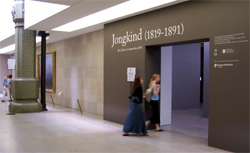 |
Barthold Jongkind (1819-1891), Dutch landscape painter who lived in France, was a precursor of the Impressionists. Monet as a young painter met him in Le Havre in 1862 and worked with him. Monet will say about Jongkind : "...completing in this the teaching I had had from Boudin, he became, from that moment, my only teacher, and I owe him the final education of my eye". The Musée d'Orsay gives an homage to this too long forgotten precursor.
|

